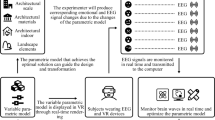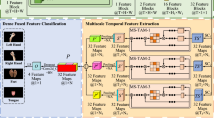Abstract
This paper puts forward a noninvasive electrooculography (EOG) and electroencephalogram (EEG)-based hybrid computer interface (HCI) system to implement the indoor target searching in three-dimensional (3D) space for a low-speed multi-rotor aircraft. The HCI system mainly consists of three subsystems, including the interface switching, decision and semi-autonomous navigation. The interface switching subsystem is accomplished by detecting the eyeblink EOG. The continuous wavelet transform is employed to indentify eyeblink features which are used to switch interfaces between horizontal and vertical motor imagery (MI) tasks. The average accuracy of the eyeblink feature detection reaches to 97.95%. The decision subsystem employs the joint regression (JR) model and spectral powers methods to extract the time and frequency domain features of MI tasks by analyzing the left- and right-hand MI EEG. Simultaneously, the support vector machine is applied to accomplish the MI tasks classification and final decision. The average classification accuracy of the HCI system reaches to 93.99%. The semi-autonomous navigation subsystem extracts the environmental features to avoid obstacles semi-automatically in 3D space and provide feasible directions for the decision subsystem. The actual indoor 3D space target searching experiments are put forward to verify the feasibility and adaptation performances of this proposed HCI system.













Similar content being viewed by others
References
Ahn JW, Ku Y, Kim DY, Sohn J, Kim JH, Kim HC (2018) Wearable in-the-ear eeg system for ssvep-based brain–computer interface. Electron Lett 54(7):413–414
Beniczky S, Conradsen I, Henning O, Fabricius M, Wolf P (2018) Automated real-time detection of tonic-clonic seizures using a wearable emg device. Neurology 90(5):428–434
Blankertz B, Mller KR, Curio G, Vaughan TM, Schalk G, Wolpaw JR, Schloegl A, Neuper C, Pfurtscheller G, Hinterberger T, Schroeder M, Birbaumer N (2004) The BCI competition 2003: progress and perspectives in detection and discrimination of EEG single trials. IEEE Trans Biomed Eng 51(6):1044–1051
Bulling A, Ward JA, Gellersen H, Troster G (2011) Eye movement analysis for activity recognition using electrooculography. IEEE Trans Pattern Anal Mach Intell 33(4):741–753
Chau AL, Li X, Yu W (2014) Support vector machine classification for large datasets using decision tree and Fisher linear discriminant. Future Gener Comput Syst 36:57–65
Choi H, Kim Y (2014) Uav guidance using a monocular-vision sensor for aerial target tracking. Control Eng Pract 22(1):10–19
Cristianini N, Shawe-Taylor J (2000) An introduction to support vector machines and other kernel-based learning methods. Cambridge University Press, Cambridge
Fattahi D, Nasihatkon B, Boostani R (2013) A general framework to estimate spatial and spatio-spectral filters for EEG signal classification. Neurocomputing 119:165–174
Fu K, Qu JF, Chai Y, Dong Y (2014) Classification of seizure based on the time-frequency image of EEG signals using HHT and SVM. Biomed Signal Process Control 13:15–22
Gandolfi M, Formaggio E, Geroin C, Storti SF, Galazzo IB, Bortolami M, Saltuari L, Picelli A, Waldner A, Manganotti P, Smania N (2018) Quantification of upper limb motor recovery and eeg power changes after robot-assisted bilateral arm training in chronic stroke patients: a prospective pilot study. Neural Plast 1:1–15
Ghasemi JB, Heidari Z, Jabbari A (2013) Toward a continuous wavelet transform-based search method for feature selection for classification of spectroscopic data. Chemometr Intell Lab Syst 127:185–194
Ghayab HA, Li Y, Siuly S, Abdulla S (2018) Epileptic EEG signal classification using optimum allocation based power spectral density estimation. IET Signal Proc 12(6):1–13
Heo J, Yoon H, Park KS (2017) A novel wearable forehead EOG measurement system for human computer interfaces. Sensors 17(7):1485
Hu S, Tian Q, Cao Y (2013) Motor imagery classification based on joint regression model and spectral power. Neural Comput Appl 23:1931–1936
Huang Q, He S, Wang Q, Gu Z, Peng N, Kai L, Zhang Y, Shao M, Li Y (2017) An eog-based human–machine interface for wheelchair control. IEEE Trans Biomed Eng 99:1
Jung TP, Humphries C, Lee TW, Makeig S, McKeown MJ, Iragui V, Sejnowski TJ (1998) Extended ICA removes artifacts from electroencephalographic recordings. Adv Neural Inf Process Syst 10:894–900
Kar S, Bhagat M, Routray A (2010) EEG signal analysis for the assessment and quantification of driver’s fatigue. Transp Res Part F Traffic Psychol Behav 13(5):297–306
Karson CN, Berman KF, Donnelly EF, Mendelson WB, Kleinman JE, Wyatt RJ (1981) Speaking, thinking, and blinking. Psychiatry Res 5(3):243–246
Kim BH, Kim M, Jo S (2014) Quadcopter flight control using a low-cost hybrid interface with eeg-based classification and eye tracking. Comput Biol Med 51(15):82–92
Lanillos P, Gan SK, Besada-Portas E, Pajares G, Sukkarieh S (2014) Multi-uav target search using decentralized gradient-based negotiation with expected observation. Inf Sci 282:92–110
Li J, Yan J, Liu X, Ouyang G (2014) Using permutation entropy to measure the changes in EEG signals during absence seizures. Entropy 16(6):3049–3061
López A, Ferrero F, Yangüela D, Álvarez C, Postolache O (2017) Development of a computer writing system based on EOG. Sensors 17(7):1505
Lotte F, Guan C (2011) Regularizing common spatial patterns to improve BCI designs: unified theory and new algorithms. IEEE Trans Biomed Eng 58(2):355–362
Lotte F, Congedo M, Lecuyer A, Lamarche F, Arnaldi B (2007) A review of classification algorithms for EEG-based brain–computer interfaces. J Neural Eng 4(2):1–13
Lührs M, Goebel R (2017) Turbo-satori: a neurofeedback and brain–computer interface toolbox for real-time functional near-infrared spectroscopy. Neurophotonics 4(4):041504
Ma J, Zhang Y, Cichocki A, Matsuno F (2015) A novel EOG/EEG hybrid human–machine interface adopting eye movements and ERPS: application to robot control. IEEE Trans Bio Med Eng 62(3):876–889
Minati L, Yoshimura N, Koike Y (2016) Hybrid control of a vision-guided robot arm by EOG, EMG, EEG biosignals and head movement acquired via a consumer-grade wearable device. IEEE Access 4:9528–9541
Moghadamfalahi M, Akcakaya M, Nezamfar H, Sourati J, Erdogmus D (2017) An active RBSE framework to generate optimal stimulus sequences in a BCI for spelling. IEEE Trans Signal Process 65(20):5381–5392
Nguyen QX, Jo S (2012) Electric wheelchair control using head pose free eyegaze tracker. Electron Lett 48:750–752
Orfanus D, Freitas ED, Eliassen F (2016) Self-organization as a supporting paradigm for military UAV relay networks. IEEE Commun Lett 20(4):804–807
Ramli R, Arof H, Ibrahim F, Mokhtar N, Idris MYI (2015) Using finite state machine and a hybrid of EEG signal and EOG artifacts for an asynchronous wheelchair navigation. Expert Syst Appl 42(5):2451–2463
Riccio A, Leotta F, Bianchi L, Aloise F, Zickler C, Hoogerwerf EJ, Kübler A, Mattia D, Cincotti F (2011) Workload measurement in a communication application operated through a P300-based brain–computer interface. J Neural Eng 8(2):025–028
Salvo G, Caruso L, Scordo A (2014) Urban traffic analysis through an UAV. Procedia—Soc Behav Sci 111:1083–1091
Samek W, Vidaurre C, Müller KR, Kawanabe M (2012) Stationary common spatial patterns for brain–computer interfacing. J Neural Eng 9(2):026013
Shi T, Wang H, Zhang C (2015) Brain computer interface system based on indoor semi-autonomous navigation and motor imagery for unmanned aerial vehicle control. Expert Syst Appl 42(9):4196–4206
Siebert S, Teizer J (2014) Mobile 3D mapping for surveying earthwork projects using an unmanned aerial vehicle (UAV) system. Autom Constr 41:1–14
Tuna G, Nefzi B, Conte G (2014) Unmanned aerial vehicle-aided communications system for disaster recovery. J Netw Comput Appl 41:27–36
Varela G, Caamaño P, Orjales F, Deibe Á, López-Peña F, Duro RJ (2014) Autonomous UAV based search operations using constrained sampling evolutionary algorithms. Neurocomputing 132:54–67
Vourvopoulos A, Badia SBI, Liarokapis F (2017) EEG correlates of video game experience and user profile in motor-imagery-based brain–computer interaction. Vis Comput 33(4):533–546
Wu W, Gao X, Hong B, Gao S (2008) Classifying single-trial EEG during motor imagery by iterative spatio-spectral patterns learning (ISSPL). IEEE Trans Biomed Eng 55(6):1733–1743
Xu B, Song A, Wu J (2007) Algorithm of imagined left-right hand movement classification based on wavelet transform and AR parameter model. In: 1st international conference on bioinformatics and biomedical engineering, pp 539–542
Yahyanejad S, Rinner B (2015) A fast and mobile system for registration of low-altitude visual and thermal aerial images using multiple small-scale UAVs. ISPRS J Photogramm Remote Sens 104:189–202
Youn E, Koenig L, Jeong MK, Baek SH (2010) Support vector-based feature selection using Fisher’s linear discriminant and support vector machine. Expert Syst Appl 37(9):6148–6156
Zhang C, Wang H, Fu R (2014) Automated detection of driver fatigue based on entropy and complexity measures. IEEE Trans Intell Transp Syst 15(1):168–177
Zhao Z, Luo H, Song GH, Chen Z, Lu ZM, Wu X (2018) Web-based interactive drone control using hand gesture. Rev Sci Instrum 89(1):014707
Acknowledgements
Tianwei Shi has been supported by the Department of Education of Liaoning Province (2017FWDF03), Natural Science Foundation of Liaoning Province of China (20180550567) and University of Science and Technology Liaoning Youth Fund (2017QN05). Wenhua Cui has been supported by the Department of Education of Liaoning Province (2016HZZD05).
Author information
Authors and Affiliations
Corresponding author
Ethics declarations
Conflict of interest
The authors declare that they have no conflict of interest.
Human and animal rights
This article contains the calibration experiments and actual indoor 3D space target searching experiments with human participants performed by the authors. Five males and five females participated in the experiments. This study was approved by the Human Research Protections Program of University of Science and Technology Liaoning and Northeastern University. Simultaneously, it was performed in accordance with the Declaration of Helsinki. All participants were asked to read and sign an informed consent form before participating in the study.
Additional information
Communicated by V. Loia.
Publisher's Note
Springer Nature remains neutral with regard to jurisdictional claims in published maps and institutional affiliations.
Rights and permissions
About this article
Cite this article
Shi, T., Wang, H., Cui, W. et al. Indoor space target searching based on EEG and EOG for UAV. Soft Comput 23, 11199–11215 (2019). https://doi.org/10.1007/s00500-018-3670-3
Published:
Issue Date:
DOI: https://doi.org/10.1007/s00500-018-3670-3




